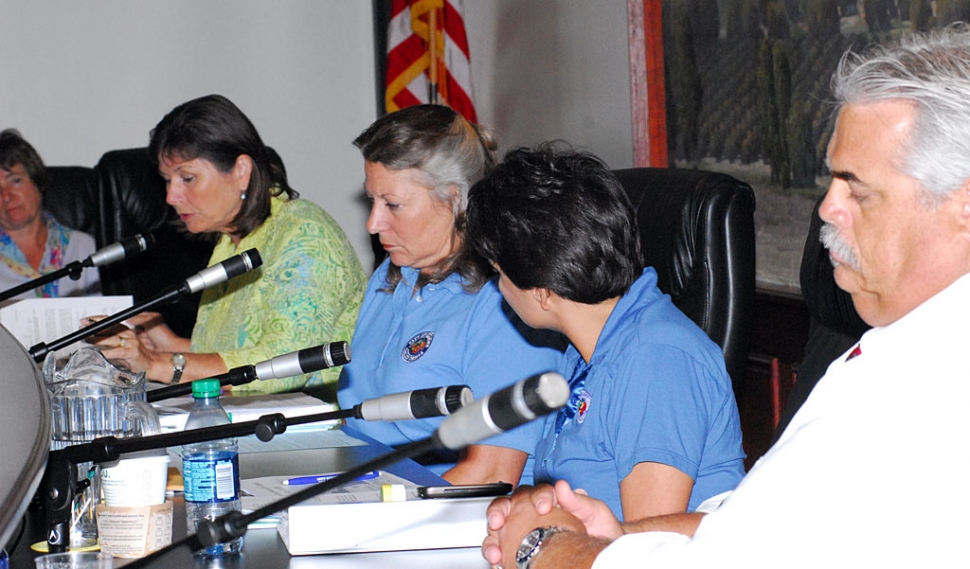|
Fillmore Business Park Modifications Accepted
 Artist’s rendering of Fillmore Business Park Master Plan. The Fillmore City Council voted Tuesday night to accept modifications to City Council-approved conditions for four Business Park projects to allow development to proceed before FEMA establishes a revised flood plain in 2015. By Naomi Klimaszewska — Wednesday, July 21st, 2010
 The Fillmore City Council voted to accept modifications to City Council-approved conditions for four Business Park projects to allow development to proceed before FEMA establishes a revised flood plain in 2015. The developers requested to change the language of condition #E5 in order for the Flood Damage Prevention Ordinance to apply when the applicants submit construction plans for plan checking. Community Development Director Kevin McSweeney explained that except for a small part of the Coe property along the Santa Clara River, the projects currently are not within the 100-year flood plain. Three months after the Business Park Environmental Impact Report (EIR) was certified, on May 8, 2008 FEMA released a draft of the Flood Insurance Rate Maps (FIRM) that indicated the Business Park would fall within the 100-year flood plain if the maps were adopted. In response, the City of Fillmore issued a formal document stating its disagreement with the flood zones on the preliminary maps. On July 8, 2008, the City Council adopted an Addendum to the Business Park EIR acknowledging that because the draft FIRMs are undergoing revisions, the City could not conclude that the severity of an environmental impact had increased. The City is not required to administer the draft map nor an applicant required to abide by it unless the draft FEMA map becomes official. If FEMA determines the Business Park to be in the flood plain after construction is complete or near completion, the applicants would be required to pay flood insurance, but not be required to remove or reconstruct buildings. “We don’t know where the flood plain will ultimately be,” McSweeney concluded. On behalf of the Business Park developers, Attorney Lisa Patricio supported the staff recommendations and thanked the staff and the council “for voting to speed this along.” Ray Harper of Fillmore Riverview LLC also registered his support, explaining that the recommendations “take away the level of uncertainty” for the developers, as the unresolved issue negatively affects the pending sale of properties. Harper said that FEMA publicly stated it would have revised flood plain maps in effect by 2015, but the County is spending thousands of dollars for research and adjustments “to ensure there won’t be a flood plain.” Jack Maxwell of Sespe Creek Properties LLC encouraged the council to adopt the recommendations, saying that while the move wouldn’t solve all problems, the County is diligently pursuing resolutions. Maxwell noted that Harper’s project is particularly important to the rest of the developers because his buildings will be the first to be built, and delays to his project would delay all the others. Maxwell also requested the council to support the County’s efforts to modify FEMA’s potential flood map. Fillmore resident Dave Roegner commented that the flood damage prevention methods (see Chapter 6.16 of the Fillmore Municipal Code) mentioned in McSweeney’s presentation, such as anchoring building pads and sealing, should be required regardless of FEMA’s final decision. Suggesting that map outlines alone wouldn’t redirect a flood, Roegner recommended the developers should abide by the 100-year flood requirements anyway, “in consideration of their customers” and in light of the energy efficiency and subsequent savings that would result by meeting the standards. Councilman Steve Conaway stated that the council would be treating the business park developers and owners as those in the residential units that would also be affected by FEMA map changes in 2015, the results of which rest on “a whole lot of speculations.” Mitigation would be the same as for any homeowner, and the challenges posed by the uncertainty of the final flood map apply to anyone in this situation; “We know we’re not alone,” he said. Referring to the flood insurance, Conaway concluded his endorsement of the recommendations, “The protection is there.” In a phone call, Conaway added that in addition to the financial protection of the insurance, there is also the physical protection of the Sespe Creek Levy already in place due to the construction of the Waste Water Treatment plant. Should the final FEMA standards require it, the levy can be retrofitted. After Councilwoman Laurie Hernandez stated she supported the recommendations, Mayor Pro-tem Gayle Washburn asked whether in the case the flood maps came back in 2015 the City would have any responsibility to fix the levy at the taxpayers’ expense. McSweeney replied no. Mayor Patti Walker related information from a presentation made by the Watershed Protection District at a recent Ventura Regional Sanitation District meeting. Walker stated that according to Director Norma Camacho, FEMA is indicating that if the District is showing that an effort is being made to fix deficiencies in levies, FEMA may extend relief of flood insurance. However, it is only providing help on projects that are a part of the FEMA program and designed by the Army Corps of Engineers. Regulations for eligibility of disaster assistance are expected to be stringent. Camacho explained in a phone call that pending passage of the Flood Insurance Reform Priorities Act (H.R. 5114), FEMA may be allowed to give reprieves of about 5 years to residents who would otherwise have to pay flood insurance, provided FEMA conditions are met. Walker cautioned the developers, “Our ordinance says we will not put any public services in harms’ way. And currently, those services are not in harm’s way. But in 2015, they may be.” She closed with a solemn warning of the possibility of the developers losing not only their businesses, but also losing their homes, should disaster strike. Due to the governor having passed a law earlier that day to extend development permits, approval of a one-year extension for the “Stop” property was pulled. Motions to approve modifications of the development permits and tentative tract maps for the four sites each passed 4-0. Note: Councilman Jamey Brooks was absent. |
